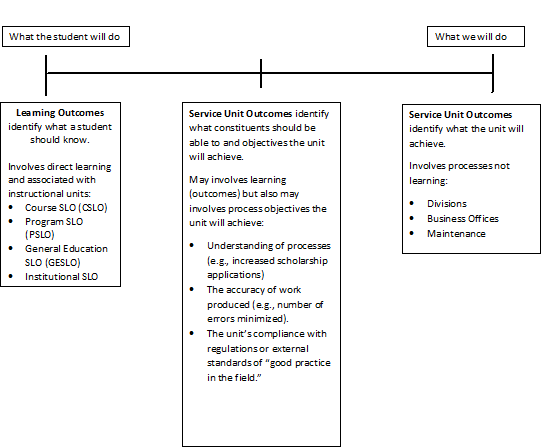SLO Resources for Faculty and Staff
On this page you will information regarding outcomes assessment based on your constituency group at the college.
Faculty and Staff
Faculty and staff engage in the process of developing and assessing student learning outcomes (SLOs) and service unit outcomes (SUOs) in a similar fashion, there are slight differences and those are indicated in the SLO and SUO sections below.
College Process for Assessment of Outcomes
Faculty and staff identify the outcome (SLOs in curriculum and SUOs as a part of a unit review), assess the outcome over four years, reflect on the assessments in program review with input from the Outcomes Assessment Committee, make any necessary changes to the outcome, and begin the cycle again.
Student Learning Outcomes and Service Unit Outcomes

Student Learning Outcomes
Discipline faculty identify course student learning outcomes (CSLOs) and program student learning outcomes (PSLOs). These are documented on the course outline of record in Curriqunet.
Developing Student Learning Outcomes
The Outcomes Assessment Committee recommends between 2-4 student learning outcomes for courses and programs. Learning outcome statements are intended to be broad and incorporate multiple objectives – they capture the overall idea of what a student should know or do as a result of taking the course or completing the program. These outcomes should change only a result of major curricular changes.
Helpful Documents:
Planning Assessment
Based on class offerings faculty determine when to assess the course student learning outcomes.
Helpful Forms:
Assessing Student Learning Outcomes
At the course level, directly assessing student learning outcomes is the most effective way to measure whether students are achieving those outcomes. Faculty should design assessment methods utilizing existing assignments rather than create an additional assignment to assess the outcome.
Helpful Forms:
At the program level, faculty must determine the best method to assess the program student learning outcomes. Direct assessment tools might include capstone course assignments, portfolios, or exam questions. Indirect assessment tools might include surveys, focus groups, or mapping.
Helpful Forms:
Documentation of Results and Follow-Up
Once faculty administer the assessment and collect results they meet to discuss the results. These discussions typically occur the semester following the assessment study and are recorded using the form below.
Helpful Forms:
- Course Level Assessment Report (docx)
This document is not accessible. If you have difficulty with it, reach out to Enrique Jauregui.
Service Unit Outcomes
Non-instructional areas develop SUOs (Service Unit Outcomes).
Developing Service Unit Outcomes
SUOs can be instructional and/or process based. These statements may identify what its constituency group (primarily students) should know/do as a result of an activity or what a unit would like to accomplish for its constituency group.
Helpful Documents:
Planning Assessment
Based individual units, employees will determine when to assess the service unit outcomes. The information can be documented in on the form below.
Helpful Forms:
- SUO Assessment Calendar (docx)
This document is not accessible. If you have difficulty, please reach out to Enrique Jauregui.
Assessing Service Unit Outcomes
Depending on the type of SUO employees within each area will determine whether to use direct or indirect assessment methods. Direct assessment methods might include portfolios while indirect assessment methods may include surveys or focus groups.
Documentation of Results and Follow-Up
Once employees administer the assessment and collect results they meet to discuss the results. These discussions typically occur the semester following the assessment study; the dialogue and planned follow-up is captured on the form below.
Helpful Forms:






